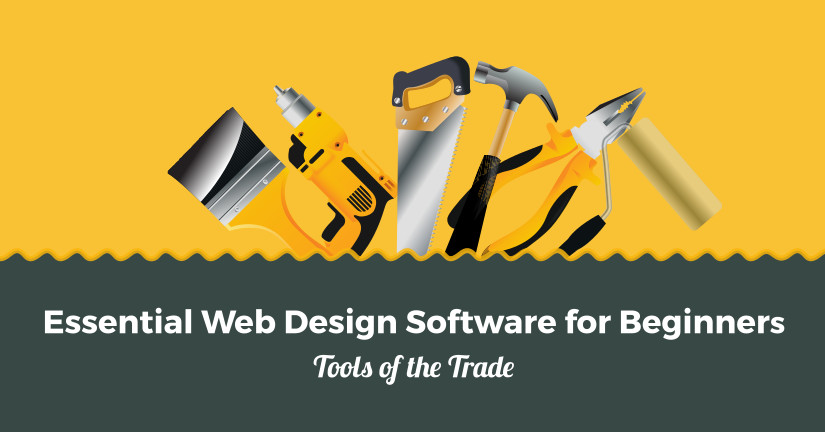Web Development Tools

knowing all web development tools can help you build a strong online presence. Have you have ever landed on a website that looked spectacular with some amazing features, and then you thought of designing a similar website? Well, if so, you are at the right place. A well-designed and well-performing website is all about the tools you have used to create your website. Also, it involves tools you are still using to maintain your website. So, in this guide, I will show you the best and most widely used web development tools to establish your website. So, let’s get busy!
The web development world and its tools never standstill. Every day a new technology evolves with some more advanced features. And professionals use them to make their designing life easier. However, if you are about to start or you have just started with web development then, the below-mentioned tools can be really helpful in the process of web development. So, let’s now find out what exactly is there. And how you can make use of them.
So, What Exactly is Web Development?
Web development is the process of building and presenting your website in an attractive manner. A good web design acts as a functional tool in highlighting the website’s image in front of its viewers. A well-built website gives an impression of superiority over the rest, which will help drive traffic to your website. Also, with the incorporation of an improved backend, and interface the number of conversions tends to automatically increase. Since a website is a reflection of your business then, it is meant to articulate your marketing message properly. Thus, these web development tools can help deliver your product to the world.
Uses of a Web Development Tools
What’s the point of having a supreme class product if your web store design sucks?
- Provides a platform to publish what your site is all about.
- Advertises the business of your company.
- Aims at making the website popular.
- Establishes the first line of communication between you and your potential visitor.
- Generates more business with a quality website
- Designs the website according to your needs.
Things to Remember While Choosing a Web Design Software
- No coding required as it is best suitable for beginners (only drag and drop option).
- No dealing with technical tasks like hosting and security updates.
- A list of testimonials to verify the past work.
- A web design software should be affordable.
- Experience
- 24/7 support.
Below is the list of must-have web development tools that are essential for beginners looking to design their first web page. However, these tools will give you an easy way to draw a rough design for your project. In fact, everything from design, mock-up to prototype and testing. Moreover, some of the below-mentioned tools allow you to add interactive features, animations, and much more. So, let’s now look at each of these web development tools one by one.
Graphic Design Software

When it comes to web design, the initial step is graphic designing. Because you have to have the best snap of the products. And for that, you need to edit the picture correctly. Almost every image that we notice today over the internet is perhaps edited or tailored with the help of graphic designing tools.
1. Adobe Photoshop ($20.99/mo)
Photoshop helps you magically transform images with the power of artificial intelligence. However, the most important thing for designing a web page is to have an attractive picture. And for that, you need a powerful editor to edit your photos. However, when it comes to editing an image, the first software that comes to everyone’s mind is Photoshop. Photoshop has all the basic editing features in it that a non-professional or a beginner can easily deal with. These essential features include cropping, color balancing, bucket fill, gradient tool text editing, magic blind-tooled eye, channel mixer, levels, sharpening, perspective correction, filters, clone stamp tool, etc. Photoshop comes with an easier and more friendly user interface. The only drawback of Photoshop is that it is much costlier as compared to others. Even then, when it comes to editing a picture, Photoshop is an undisputed king.
- Version: Photoshop 2021 (version 22.3.1)
- Operating System: Windows, iOS, Android, Windows Phone
- Rating: 4
Pros
- Slick interface.
- Integrated stock library.
- Loads of design tools for mobile and Web.
- The ultimate in photo correction and manipulation.
- Content-aware move and patch.
- Video editing.
- Complementary mobile apps.
- 3D design capability.
Cons
- No perpetual license option.
- The interface can be a bit overwhelming.
- Some tools tend to not show progress bars.
2. GIMP (Free)
GIMP is considered the best alternative to Photoshop when users compared the two. You will see several basic editing features like cropping, color balance, bucket fill, magic bind tool, gradient tool, text editing, red-eye, filters, sharpening, levels, etc. GIMP also offers the same features similar to Photoshop. To make your GIMP look and run similar to Photoshop’s latest Photoshop CC version, GIMP offers few extensions that one can be download for free. Few include FX-Foundry, Resynthesizer, Save for the Web, Layer Effects, and GIMP Paint Studio.
- Version: 2.10.24
- OS: Windows, Mac, Linux
- Rating: 3.9
Pros
- Easily expandable.
- Packed with features and tools.
- Opens almost any image file.
Cons
- The interface is a little cluttered.
3. Adobe Illustrator ($20.99/mo)
Adobe Illustrator is a vector graphics designing software with all features like sketching, coloring, editing, one-click paint bucket fill, scale, move, rotate pixels, editing on SVG source code but not for free. With the help of Adobe Illustrator, the editor can create icons, sketches, logos, complex illustrations typography, and much more. It supports all file formats including.EPS that Inkscape lacks. One can even export his artwork in.JPEG format. Illustrator comes with a polished and oversimplified interface to offer more friendliness to beginners as well as professionals. It provides extensive customer support as well as some video tutorials, chats, and calls customer care.
- Version: Illustrator 25.2
- Rating: 4
Pros
- All-encompassing toolset.
- The color themes panel is ace.
- Awesome new typography tools
Cons
- Expensive (both as a single app and part of CC).
4. Inkscape (free)
Inkscape is a free software for vector graphic designing. It provides all features for free including coloring, sketching, editing the SVG source code, edit notes using the keyboard; moves, rotate, scales pixels, one-click paint bucket fill. In case you feel some features lack in Inkscape, we advise you to check and download its extension as per your need. Inkscape has a very friendly user interface as it is easy to use especially for beginners. It converts Bitmap to vector files automatically. If you are on the lookout for Web Development Tools then Inkscape is the one as it has an open community forum for its users to question and answer all their queries.
- Version: 1.0.2
- Runs On: Windows, Mac, Linux
- Rating: 4
Pros
- Incredible file format support.
- Amazing selection of vector-editing tools.
- Expandable via plugins.
Cons
- Processing can be a bit sluggish.
5. Sketch ($99/one time)
The Sketch is built for modern graphic designers, pertaining to powerful features like ‘Symbols’ and ‘Shared Styles’. It offers support for Multiple Pages and Artboards. Moreover, it has a fully vector-based workflow which makes it easy to create beautiful, high-quality artwork from start to finish. It also has a lightweight and easy-to-use package.
- Version: 71.1
- Works With: Mac
- Rating: 3.5
Pros
- A robust tool for UI design
Cons
- Its pen tool and bitmap capabilities aren’t as robust as Photoshop and Illustrator
6. Balsamiq ($89/one time)
Balsamiq is a rapid wireframing tool that helps you work done faster & smarter. This shows us that making mockups is fast. It can build a user interface at the speed of thought. It comprises tons of UI elements. You’re just required to drag and drop. Balsamiq can print out your prototypes or run online user tests, before writing codes. It often reproduces the experience of sketching on a whiteboard, but on a computer.
- Version: Mockups 4.2.4
- Available For: Mac and Windows
- Rating: 4.3
Pros
- The tool is cost-effective.
- Ease of maintaining multiple users or a team.
Cons
- Not a strong set of tools for designing UI elements.
Framework/Template Code

Frameworks are the ones that help you to build the foundation or the base of any website. Using these tools, you can code the basic template of your website. Henceforth, your website can’t run efficiently with poorly coded frameworks. In order to fulfill your search for Web Development Tools, you can try these frameworks for designing your site.
7. Bootstrap
Bootstrap is one of the most popular front-end development frameworks, with its 3rd version already in the market. It comes with amazing features, navigation elements, and structured grid system, etc. A beginner whether being technical or not, whether being professional or nonprofessional, can easily build a website with Bootstrap’s natural framework. Beginners can take help from the startup guide while initiating web development tasks. Bootstrap also gives you the option to create fixed and fluid width layouts and also supports mobile.
- Version: 4.6
- Rating: 4.1
Pros
- Great documentation.
- Supports responsive embeds.
- A wide variety of themes.
Cons
- Large file size out of the box.
- Websites can start to look the same.
8. Foundation
Foundation is an ultra-responsive framework used to build seamless designs to create web applications, websites, email templates, and mobile. It is reported as the easiest framework to learn for a beginner. Foundation also includes exceptional plugins to offer developers to choose from according to the one they require. It includes some components like library containers, layouts, media, navigation, etc.
- Version: 6
- Rating: 4
Pros
- Finest customization
- Robust grid system
- An extensive set of templates with ready-made codes
Cons
- Not as popular as Bootstrap.
- Modifying codes won’t be easy for beginners or early developers.
9. YAML
YAML provides a complete editing experience in Visual Studio which involves functionalities like Syntax highlighting, syntax error detection, Format document, Comment/uncomment selection, Insert spaces on {TAB}.
Its latest version 1.6.2 offers added support to VS 2015.
- Version: 4.1.2
- Rating: 3.8
Pros
- Easy customization.
- RTL support.
- Extensible with a selection of add-ons.
Cons
- Can be hard for beginners.
10. mini.css
mini.css is a lightweight, responsive, unobtrusive, style-agnostic CSS framework that is under 7KB gzipped. It has full-fledged modules that can support complex UI patterns and website designs. It works on all devices.
- Rating: 3
Pros
- Flexbox-based
- Active developer
Cons
- Not widely used.
Code Editors/IDE

Once the template and base framework of the website is ready, there are going to be multiple hit and trial sessions for code testing, execution, and making changes in the code. That is when code editors come to use.
11. Dreamweaver
Dreamweaver is an amazing code editing tool from the Adobe family. It comes with visual design features known as Live view along with some usual code editing options like syntax highlighting, code collapsing, etc. Dreamweaver also comes with a feature that facilitates users to check the syntax in real-time which further assists the user to make appropriate changes in the code. Apart from mere code editing, Dreamweaver also lets its user upload his or her code to the server using FTP or SFTP.
- Version: 21.1
- Windows and Mac
- Rating: 4
Pros
- Enhancements to code view including multi-cursor support.
- Real-time preview.
- Auto-recovery of files.
Cons
- No ASP support.
12. Notepad++
Notepad++ is a code editing tool for the Windows platform. Having been inherited its name from a C programming language operator, one of the most amazing features of Notepad++ is that it lets its users edit multiple documents of codes at a time. Moreover, on the off chance that you forget to save your edited files, then I must tell you that Notepad++ automatically backs up your unsaved files.
- Version: 7.9.5
- Install On: Windows
- Rating: 3.8
Pros
- Extendable via plugins.
- Multi-line editing.
- Syntax highlighting.
Cons
- Outdated UI
13. CodeLobster
Codelobster is a perfect IDE code editing tool for primarily editing codes in PHP language, though it supports HTML, CSS, and JavaScript too. Although the tool is paid, users can avail a 30-day free trial and then choose the plan according to their needs if they like this code editor. It also features plugins for various CMS platforms like WordPress, Drupal, Joomla, etc. Another amazing feature of this code editor is that it comes if an auto-complete function for SQL commands.
- Version: 5.15
- Mac, Windows, and Linux
- Rating: 3.7
Pros
- Portable option available.
- Special support for JQuery.
Cons
- Expensive
14. Nova ($99)
This Nova tool is a fresh approach to web code bursting with features without any bloat. It contains some highly-requested features in groundbreaking UI fit for the future. Nova has provided a trimmed-down alternative to expensive web design suites. It has built-in support for CoffeeScript, CSS, JavaScript, Diff, ERB, JSON, Haml, HTML, INI, JSX, Less, PHP, Lua, Ruby, Markdown, Perl, Python, Sass, TSX, SCSS, Smarty, SQL, XML, and YAML, TypeScript. It has full-featured, flexible, and hyper-fast text editors
- Version: 7.0
- Mac and iOS
- Rating: 3
Pros
- Real IDE with all the benefits.
Cons
- Support for Mac and commercial use only.
15. Sublime Text 3 Build 3103
This Sublime Text 3 Build 3103 text editor has a slick user interface, wonderful features, and provides an amazing performance. Build 3103 highlights a custom regex engine that speeds up file loading and indexing significantly. It is available with the new syntax definition format i.e., ‘.sublime-syntax’.
It contains the ‘multiple selections’ option which allows you to a number of lines at once, renames variables with ease, and manipulate files way faster. Sublime Text 3 Build 3103 can also perform the function of Split Editing. Its Go-to Anything’ option enables instant jumping from words, symbols, or lines.
- Version: Build 3211
- OS X, Windows, and Linux.
- Rating: 4
Pros
- Autocompletion
- Customizability
- Multiple selections
- Simultaneous Editing
Cons
- Not beginners’ friendly
16. Cloud9
Cloud9 is an online code editor with an Ubuntu workspace in the cloud with support for Python, Ruby, JavaScript, Go, etc. It assists more than 40 languages, with class build WordPress, Django, and Rails websites. It is capable of smoothly handling hundreds of thousands of files in your workspace and hundreds of thousands of lines of code in the editor.
- Version: 3
- Installs On: Mac
- Rating: 4.1
Pros
- Terminal with root access
- Browser testing support
- Great documentation
Cons
- Lacks a built-in Java builder and runner
Content Management System (CMS)

As the name says, a CMS is a full-fledged and highly secured system. Hence, in a way, your website can not function properly in the absence of a good CMS. However, there are several benefits of using a content management system. If you are on a spree to find web development tools, you shouldn’t miss checking out these CMSes.
17. WordPress
WordPress is the largest self-hosted blogging platform developed in 2003 that millions of sites and people use every day. It is a free tool run by hundreds of individuals all over the world simultaneously. WordPress is a full CMS with thousands of plugins and themes which make its functionality nearly limitless. Almost every website is ranging from simple to blogs, enterprise, applications, portals, professional portfolio, magazine, news, etc. are built on WordPress. It makes management of content easier with various tools like creating a draft, post revision, making content public or private, password protection to access, and much more. WordPress also gives you permission to post media. It is available in more than 70 languages.
- Version: 5.7.1
- Rating: 4.5
Pros
- Widely used and open source.
- Self-host & WP-host options.
- Complete control if needed.
Cons
- A bit of bloat.
18. Joomla
Joomla is a content management system that keeps track of every piece of content on your website. Unlike WordPress, it also helps one in building websites and other online applications. It is also an open-source solution and is free to use and download. Various features of Joomla include Corporate websites, Corporate Intranets and Extranets, E-commerce and online reservations, an online newspaper, publications, magazines, government applications, school websites. Small business sites etc. It has an easy user interface that helps even beginners to use the software with a lot of ease. With its user guides and videos, the designer can empower his clients to manage their site themselves. It also provides various extensions (mostly for free) for specialized functionality and customer satisfaction.
- Version: 3.9
- Rating: 4.4
Pros
- Highly customizable.
- Powerful and user-friendly admin interface.
- Great for social networking and commerce sites.
Cons
- Quality extensions are rare.
19. Magento
Magento is an open network e-commerce platform. The software is written in PHP language with an aim to provide new ways to smooth navigation, overall revenue generation, conversion rates, etc. Magento offers three different user programs.
Magento Community Edition: It is an open-source ECommerce platform where developers can extend functionality with the help of plugins and implement the core files.
The Magento Enterprise Edition: It has the same core files as Magento Community Edition with more features and functionality but is not free. Magento bought this edition to satisfy large business sites that require technical support while troubleshooting, usage, and configuration.
Magento Enterprise Cloud Edition: This edition empowers fast organization of completely adjustable, secure, and adaptable web retail facades, joined with leading hosting and managed infrastructure. It contains a full REST API and a scriptable order line interface that guarantees simplicity of joining with outer frameworks and similarity with existing code administration work processes. The latest software from Magento is Magento 2.
- Rating: 4
Pros
- Multilingual capabilities.
Cons
- eCommerce platform focused only.
20. Drupal
Drupal is open-source software that can be used for free. With a simple user interface, it becomes handy for beginners to manage several types of websites. Drupal is a CMS and a development framework. A few features that Drupal includes are content authoring, great security, and reliable performance. Drupal’s flexibility and modularity set it apart from all other content writing software available. One can extend Drupal’s features with the help of add-ons, modules. One can even integrate it with other external services and applications in their infrastructure.
- Version: 8
- Rating: 4.4
Pros
- Excellent SEO.
- Good accessibility.
- Great for enterprise use.
Cons
- High resource consumption.
TemplateToaster – The All-in-One Solution

TemplateToaster is the best Web Development Tools for beginners as well as professionals according to the reviews from all people who already used it. With this software, one can design high-end WordPress themes along with Drupal, Magento themes, Joomla templates HTML5/CSS3 websites. It supports RWD which makes a website open perfectly over all devices including smartphones and tablets. Developers can easily add social media buttons to the website. When it comes to graphics and media, TemplateToaster is very useful in designing HTML5/CSS3 websites with WYSIWYG Editor. It even gives the developer an option of slideshow effects, logos, textures, stock images, graphics, all the computer fonts, google fonts.
Small Handy Tools (Browser Addons)

Firefox and Chrome Addons are pretty simple, but useful tools when it comes to web designing. These tools can help you to set basic functions like ruler margin, or help you to collaborate easily by sharing screenshots with team members, or help you in determining minor details about a website.
21. Firebug
Firebug generates a tremendous amount of tools while browsing. With Firebug, one can edit, monitor CSS, HTML, JAVASCRIPT live on any page and edit. It helps to search deeply buried HTML elements and edit them on the page. With Firebug’s CSS one can easily check the style of the web page and make changes in them and see the effect instantly. It measures and informs all the margins, offsets, padding, and borders.
In case your page is taking a long time to load, one has written a lot of javascript, forget to compress images; no issues, Firebug will do the work for you with the powerful Javascript debugger. It informs you in case you made any errors in Javascript, HTML, XML, or CSS. It gives users powerful logging functions to receive quick replies. The rapid search box in its toolbar provides you with a feature to see the results of your search inside Firebug’s panels. It is available for both Firefox and Google Chrome.
- Version: 2.0.19
- Rating: 4
22. Color Picker
With a color picker, one can easily create, experiment, and adjust to custom colors of the web. It also makes color format conversion between CSS, Hexa colors, RGB, and HSL easy. Also, Color Picker also makes control over the alpha channel on RGB and HSL formats. On the other hand, each of the three colors comes out in all three standard web CSS formats. The user can toggle the eyedropper style color picker box between HSL and HSV formats.
- Version: 5.5
- Windows and Mac
- Rating: 3.9
23. Page Ruler and Grid Ruler
It is used to get pixel dimensions and positioning and calculate elements on any web page. It draws a ruler on any page and displays its width, height, and position. Users can drag the edges of the ruler to resize it. You can change the size of the ruler with just the arrow keys. They can update the size and position of the ruler from the toolbar. With the help of Element Mode, users can outline elements on the web page by moving the mouse over it.
- Version: 0.2.1
- Works With: Windows
- Rating: 4
24. BuiltWith
When it comes to BuiltWith extension as a tool for newbie web designers, it is more of a reverse engineering tool. In the event that you land on a beautifully designed website and would like to know what its basic framework is. There you just need to click on the BuiltWith icon. BuiltWith supports a variety of options from various aspects such as Blogger, WordPress (publishing platforms), DoubleClick, AdSense (advertising), .NET, Java (frameworks), etc.
- Version: 3.3
- Available For: Windows
- Rating: 4.3
25. Usersnap
Usersnap is a teamwork-oriented tool. However, it is a simple browser extension that lets you take a screenshot of any web page on the internet and share it with your teammates, clients, or other developers. Apart from sharing feedbacks and screenshots, Usersnap also facilitates users to integrate their existing projects and bug tracking systems. Hence, Usersnap can help you to fix any web designing issue pretty faster.
- Version: 0.1.9
- Available For: Windows
- Rating: 4
26. Responsive Check
Nowadays, it is very important for your website to be responsive to various devices. No matter how beautiful or attractive your website is, but if it is not responsive then it can’t satisfy the ultimate users. However, to manually check your website’s responsiveness, you can use the following shortcuts.
- Chrome: F12 → Mobile Icon on the top-left corner of Inspect Element Window
- Firefox: Ctrl+Shift+M
- Internet Explorer/Edge: F12 → Emulation
Web Development Tools – In Conclusion
So, these are some of the basic web design and website design tools for beginners. Here, I have tried to include at least one tool for each aspect of web development. However, TemplateToaster comes out to be an all-in-one package since it provides a lot of features in one place. Also, TemplateToaster does not have any compatibility issues, be it with frameworks or CMS and their respective plugins. So, now you are all set to experiment with your first piece of web design. If you still have any questions, please feel free to leave me a message below in the comments below.
Build a Stunning Website in Minutes with TemplateToaster Website Builder
Create Your Own Website Now
The tools which are very useful for webdesign and website development are explained well here.
Really great list for those who are just starting with webdev!
I visited your website you have a good looking website and also I have read this article. I like it and well done Keep it up. I too also written an amazing article once check it out web development tools for beginners.
If you are beginner, you may try free tools for development.